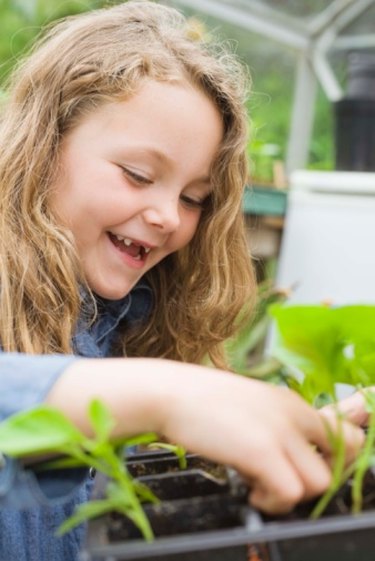
Growing your own vegetables is a rewarding way to put health food on your plate. Vegetable plants go through a series of stages of growth, from seed to the end of their seasonal growing cycle. Understanding the growth stages for vegetables helps you to plan your garden for optimal production and space efficiency, since you can start new seedlings to fill in when other plants are reaching the end of production.
Germination and Vegetation
Video of the Day
Germination is the plant's process of beginning growth. The seed contains all the energy a plant needs to develop from the embryonic stage until it has its first set of true leaves. Once the plant reaches the vegetative growth stage, it requires nutrients from the soil. Fertilize vegetable plants regularly during vegetative growth, advises the Colorado State University Extension, establishing a strong plant frame to bear a large vegetable harvest. Leafy green vegetables like cabbage, lettuce and spinach are harvested during the height of the vegetative growth stage, and can become bitter once they go on to flowering production.
Video of the Day
Flowering
The flowering stage is important to vegetable gardeners. If your plants are stressed during flowering, you will not enjoy a productive crop of vegetables. Water regularly, be attentive to bug damage and cover the plants if there is danger of frost, but uncover them to allow pollination during daytime hours. The underlying frame of the plant is complete once the plant reaches the flowering stage, so you can stop regular fertilizing at this point.
Fruiting
Fruiting is the reproductive stage of vegetable plant development, where the part of the plant favored for consumption is produced in types of garden vegetables such as tomatoes, peppers, eggplants, cucumbers, melons and squash. Calcium is an important building block of these large garden vegetables, and most will benefit from an extra dose of calcium-containing soil amendments during the fruiting stage. The fruiting stage also includes seed production in herbs like cilantro or fennel, and can occur in the second year for biennial plants grown for seed production such as celery and onions.
Senescence and Dormancy
Senescence is the plant's process of winding down for the season. For annual vegetables, or tropicals like eggplants grown as annuals in most of North America, the plants can be removed from the garden as soon as fruiting stops to make room for end-of-season crops. For plants grown as biennials, like artichokes, or perennial fruit bushes and trees, adding fertilizer during senescence will help the plant grow hardy root stock to make it through the winter. Perennial and biennial plants then enter the dormant stage, where all the energy is withdrawn into the center of the plant to await awakening by next spring's warm sun and rain.
- Colorado State University Extension; Push Growth on Vegetables Early; Carl Wilson
- West Virginia University Extension Service; Plant Growth and Development as the Basis of Forage Management; Edward B. Rayburn; December 1993
- Plant Ontology Consortium: Growth Stage Ontology -- Objectives and Rationale
- University of Illinois Extension Great Plant Escape: Germination